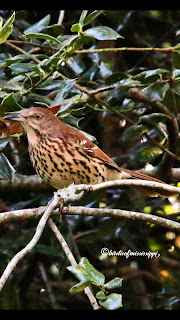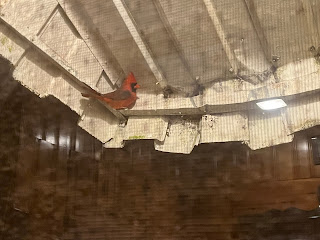Look at That Beak! - 4/8/20
Look at That Beak!
By PEGGY WILLIAMS AKA Birdie of Mississippi
On Saturday as I was photographing birds at my feeders, I was very excited to see a beautiful Red-bellied Woodpecker. Usually woodpeckers come only to my suet feeders, but lately due to all the rain they have needed the energy that suet and sunflower seeds give them. As I watched this woodpecker through my camera’s zoom lens I noticed his very long beak. This caused me to think about “bird beaks”.
The size, shape, color and texture of a bird’s beak varies from bird to bird and they use their beak for many things. The beak is also called a bill and/or rostrum and it is used for a variety of actions such as eating, preening their feathers, digging out food, fighting, courting, and feeding their chicks. Depending on the type of bird such as hawks and eagles they may even use their beak for killing prey. The beak is divided into upper and lower mandibles that open and shut by using their jaw muscles. These muscles also attach the beak to their skull.
Birds don’t have teeth, but some birds do have sharp notches or ridges on their beaks that can act somewhat like teeth. These can help them crack seed hulls, rip insects apart or hold on to slippery, wriggling prey or even to fatally wound their prey. Ducks use their beak to filter through the water that they are swimming in to get little bugs or pieces of plants.
Some birds even have bristles all along their beaks such hummingbirds which helps them to hold on to insects or to get nectar from flower corollas that are long or waxy. The hummingbird uses his beak similar to a turkey baster and sucks up sweet flower nectar through it.
The beak’s color can come in a rainbow of different colors and can help Birders easily identify different species of birds. Colors in certain areas of the beak can even trigger baby birds to begin begging for their food when they see that color on his mother’s beak.
The length of the beak such as the woodpecker’s beak acts as tweezers to squeeze out bugs wedged in the wood of decaying trees. Water birds such as herons and cranes use their giant beaks to pluck fish out of the water and down their throats.
As I considered the different shapes of beaks I also took a different look at my bird feeders. Some feeders work better for some birds than others. In fact, I have decided to design bird feeders of my own. Some really expensive bird feeders don’t work for the birds that they are intended for. I have a beautiful tube feeder given to me and I have watched birds land on it, but then fly away after a few frustrating tries to get a seed. This feeder remained full of sunflower seeds even though all other feeders would be empty. After closer inspection I discovered why. The holes recessed so far back that a small bird’s beak could not reach the seed. Birds with a long enough beak couldn’t sit on the perch and bend to reach into the hole! So I emptied that tube and put all the wonderful seed into other feeders. Once again as I “look at the birds of the air” Matthew 6:26 I discover more and more about these beautiful creatures of God.




Comments
Post a Comment